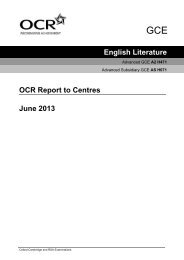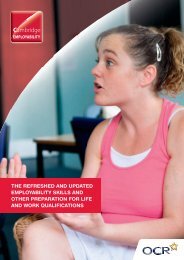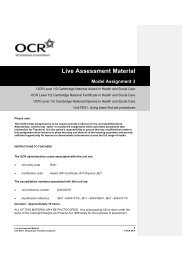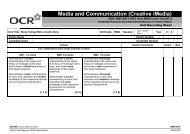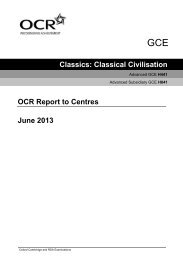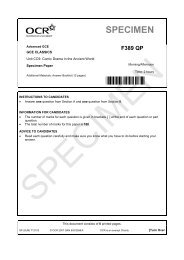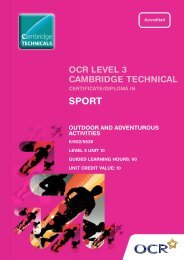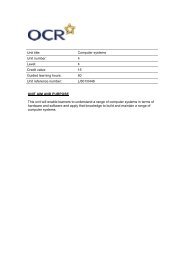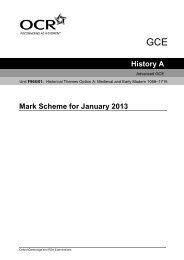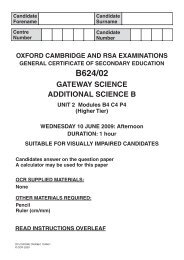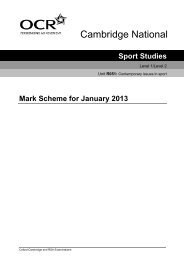Mark scheme - Unit F225 - Genetics, control and ageing ... - OCR
Mark scheme - Unit F225 - Genetics, control and ageing ... - OCR
Mark scheme - Unit F225 - Genetics, control and ageing ... - OCR
Create successful ePaper yourself
Turn your PDF publications into a flip-book with our unique Google optimized e-Paper software.
GCE<br />
Human Biology<br />
Advanced GCE<br />
<strong>Unit</strong> <strong>F225</strong>: <strong>Genetics</strong>, Control <strong>and</strong> Ageing<br />
<strong>Mark</strong> Scheme for January 2013<br />
Oxford Cambridge <strong>and</strong> RSA Examinations
<strong>OCR</strong> (Oxford Cambridge <strong>and</strong> RSA) is a leading UK awarding body, providing a wide range of<br />
qualifications to meet the needs of c<strong>and</strong>idates of all ages <strong>and</strong> abilities. <strong>OCR</strong> qualifications<br />
include AS/A Levels, Diplomas, GCSEs, Cambridge Nationals, Cambridge Technicals,<br />
Functional Skills, Key Skills, Entry Level qualifications, NVQs <strong>and</strong> vocational qualifications in<br />
areas such as IT, business, languages, teaching/training, administration <strong>and</strong> secretarial skills.<br />
It is also responsible for developing new specifications to meet national requirements <strong>and</strong> the<br />
needs of students <strong>and</strong> teachers. <strong>OCR</strong> is a not-for-profit organisation; any surplus made is<br />
invested back into the establishment to help towards the development of qualifications <strong>and</strong><br />
support, which keep pace with the changing needs of today’s society.<br />
This mark <strong>scheme</strong> is published as an aid to teachers <strong>and</strong> students, to indicate the requirements<br />
of the examination. It shows the basis on which marks were awarded by examiners. It does not<br />
indicate the details of the discussions which took place at an examiners’ meeting before marking<br />
commenced.<br />
All examiners are instructed that alternative correct answers <strong>and</strong> unexpected approaches in<br />
c<strong>and</strong>idates’ scripts must be given marks that fairly reflect the relevant knowledge <strong>and</strong> skills<br />
demonstrated.<br />
<strong>Mark</strong> <strong>scheme</strong>s should be read in conjunction with the published question papers <strong>and</strong> the report<br />
on the examination.<br />
<strong>OCR</strong> will not enter into any discussion or correspondence in connection with this mark <strong>scheme</strong>.<br />
© <strong>OCR</strong> 2013
<strong>F225</strong> <strong>Mark</strong> Scheme January 2013<br />
Abbreviations, annotations <strong>and</strong> conventions used in the detailed <strong>Mark</strong> Scheme.<br />
Annotation Meaning<br />
/ alternative <strong>and</strong> acceptable answers for the same marking point<br />
(1) separates marking points<br />
not<br />
answers which are not worthy of credit<br />
reject<br />
answers which are not worthy of credit<br />
ignore<br />
statements which are irrelevant<br />
allow<br />
answers that can be accepted<br />
( ) words which are not essential to gain credit<br />
__<br />
underlined words must be present in answer to score a mark<br />
ecf<br />
error carried forward<br />
AW<br />
alternative wording<br />
ora<br />
or reverse argument<br />
Annotations: the following annotations are available on SCORIS.<br />
Annotation<br />
Meaning<br />
correct response<br />
incorrect response<br />
benefit of the doubt<br />
benefit of the doubt not given<br />
error carried forward<br />
information omitted<br />
ignore<br />
reject<br />
1
<strong>F225</strong> <strong>Mark</strong> Scheme January 2013<br />
Highlighting is also available to highlight any particular points on the script.<br />
The following questions should be annotated with ticks to show where marks have been awarded in the body of the text:<br />
2
<strong>F225</strong> <strong>Mark</strong> Scheme January 2013<br />
Question Answer <strong>Mark</strong>s Guidance<br />
1 (a) (i) phenotype<br />
idea of observable characteristics / AW ;<br />
1 ALLOW trait(s)<br />
(ii)<br />
how two different genotypes can result in the<br />
same phenotype<br />
I A (allele) is (co)dominant ;<br />
i / I O , (allele) is recessive ;<br />
4 IGNORE reference to positive or negative.<br />
CREDIT equivalent answers for blood group B / I B<br />
DO NOT CREDIT A B or O as an allele symbol but penalise<br />
once only<br />
DO NOT CREDIT I A as a blood group but penalise once.<br />
'I O is recessive to I A ’ OR reverse argument would score 2<br />
marks (as both mp 1 <strong>and</strong> 2 are implied)<br />
(so) blood group A (genotype) could be ,<br />
homozygous / I A I A ;<br />
(or) blood group A (genotype) could be ,<br />
heterozygous / I A i / I A I O ;<br />
CREDIT answers shown on diagram<br />
DO NOT CREDIT incorrect use of gene / genotype /allele but<br />
penalise once only<br />
(b) (i) prophase ;<br />
1 (one) ;<br />
2 CREDIT 'Meiosis 1, prophase' (2 marks)<br />
(ii) F ; 1 <strong>Mark</strong> the first answer. If the answer is correct <strong>and</strong> an<br />
additional answer is given that is incorrect or contradicts the<br />
correct answer then = 0 marks<br />
1
<strong>F225</strong> <strong>Mark</strong> Scheme January 2013<br />
Question Answer <strong>Mark</strong> Guidance<br />
(iii) autosomal<br />
3<br />
not a sex chromosome ;<br />
CREDIT reference to chromosome 9 being an autosome<br />
AND ANY TWO FROM<br />
linkage<br />
loci F <strong>and</strong> G close together (on chromosome) ;<br />
less chance of a ,<br />
cross over event / chiasma formation, between them ;<br />
ACCEPT reference to genes or<br />
to genes for ABO <strong>and</strong> nail patella syndrome.<br />
CREDIT reverse argument - both exchanged together during<br />
cross over event<br />
(so more likely to be) inherited together ;<br />
2
<strong>F225</strong> <strong>Mark</strong> Scheme January 2013<br />
Question Answer <strong>Mark</strong>s Guidance<br />
(c) (messenger / m) RNA ;<br />
2 ACCEPT RNA unqualified<br />
DO NOT CREDIT rRNA or tRNA<br />
another transcription factor ;<br />
protein / polypeptide ;<br />
(d) Symptoms<br />
3 MARK UP TO TWO SYMPTOMS<br />
(leads to) reduced field of vision / tunnel vision ;<br />
idea of misty vision ;<br />
'halos' around objects ;<br />
red / bloodshot eyes ; 2max<br />
changes in the eye<br />
(tests detect) increased pressure inside eye ;<br />
(gradual) damage to optic nerve ;<br />
ref to closed / open angle ;<br />
2max<br />
MARK UP TO TWO CHANGES<br />
CREDIT description of changes in eye which reduce<br />
drainage of fluid<br />
3
<strong>F225</strong> <strong>Mark</strong> Scheme January 2013<br />
Question Answer <strong>Mark</strong> Guidance<br />
(e) idea that basement membrane no longer<br />
acts as molecular filter ;<br />
3 Can be awarded if c<strong>and</strong>idate refers to reduced efficiency of<br />
filtration.<br />
CREDIT idea that ‘cut off’ size is no longer 70 000 Daltons /<br />
large molecules / proteins leave blood<br />
idea of substances entering, bowman’s capsule / filtrate ;<br />
(protein) not reabsorbed ;<br />
erythrocytes / red blood cells ,<br />
present in urine ;<br />
DO NOT CREDIT ‘glucose’ as this normally appears in the<br />
filtrate<br />
DO NOT CREDIT protein if given as part of a list with<br />
glucose but penalise once only.<br />
eg ‘Glucose, protein <strong>and</strong> red blood cells will be present in<br />
urine’ would score 1 mark.<br />
protein present in urine ;<br />
Total 19<br />
4
<strong>F225</strong> <strong>Mark</strong> Scheme January 2013<br />
Question Answer <strong>Mark</strong>s Guidance<br />
2 (a) mechanism<br />
M1 (regulated by) negative feedback ;<br />
M2 stimulus is rise in blood glucose / ORA ;<br />
9max<br />
CREDIT fall in blood glucose is stimulus for glucagon<br />
release.<br />
M3 (rise or fall) detected by (cells in) Islets of<br />
Langerhans ;<br />
M4 (rise in blood glucose) / beta , cells release insulin ;<br />
M5 insulin stimulates increased uptake of glucose by ,<br />
liver / muscle , cells ;<br />
M6 (insulin stimulates) increased respiration<br />
M6 ACCEPT glucose respired instead of fats<br />
of glucose ;<br />
M7 (insulin stimulates) conversion of glucose<br />
to glycogen / glycogenesis ;<br />
M8 (fall in blood glucose) α / alpha , cells<br />
release glucagon ;<br />
M9 glucagon stimulates , glycogenolysis /<br />
CREDIT conversion of , amino acids / AW , to glucose<br />
breakdown of glycogen to glucose ;<br />
M10 (glucagon stimulates) gluconeogenesis / described ;<br />
M11 (glucagon stimulates) increased respiration of fats /<br />
less respiration of glucose ;<br />
reasons<br />
R1 idea that glucose has an osmotic effect ;<br />
R2 water drawn out of cells (by osmosis) ;<br />
R3 (water loss) leads to , cellular damage / described ;<br />
R4 idea that high glucose results in increase in<br />
blood,volume / pressure (leading to heart attacks) ;<br />
R5 blood glucose is respiratory substrate ;<br />
R1 CREDIT for correct reference to high <strong>and</strong> low water<br />
potential<br />
R3 ACCEPT any named example of damage due to high<br />
blood glucose eg neuropathy / retina damage<br />
R7 ACCEPT ref to low blood glucose leading to dizziness<br />
5
<strong>F225</strong> <strong>Mark</strong> Scheme January 2013<br />
Question Answer <strong>Mark</strong>s Guidance<br />
R6 necessary for neurones / AW ;<br />
R7 ref to (diabetic) coma ;<br />
Look for a general comment on the use of glucose in<br />
respiration in cells for R5<br />
QWC ; 1 Award QWC if answer has been awarded<br />
at least 3 M marks plus R1 <strong>and</strong> R5.<br />
6
<strong>F225</strong> <strong>Mark</strong> Scheme January 2013<br />
Question Answer <strong>Mark</strong>s Guidance<br />
(b) (i)<br />
2 <strong>Mark</strong> the first answer. If the answer is correct <strong>and</strong><br />
an additional answer is given that is incorrect or<br />
contradicts the correct answer then = 0 marks<br />
BMI < 20 / BMI > 40 ;<br />
all data, on / close to, the line ;<br />
(ii) confidence limit increases / AW ;<br />
ACCEPT ‘confidence limits very, small, narrow’<br />
2 ACCEPT idea that zone gets wider<br />
idea that this data is ,<br />
generated by the model / not real, actual data /<br />
extrapolated ;<br />
idea that there is no guarantee that ,<br />
conditions / factors , affecting this will occur as expected ;<br />
(iii) from Table 2.1<br />
(large) increase risk of diabetes (over time) in<br />
groups where BMI is greater ;<br />
data quote in support ;<br />
from fig. 2.1<br />
percentage of people in higher (risk) BMI<br />
categories increases (over time) ;<br />
data quote in support ;<br />
3<br />
CREDIT idea that data is more of an estimate<br />
IGNORE ref to ‘predictions’ as this is given on the<br />
graph<br />
CREDIT idea that eg lifestyle could change in the<br />
future<br />
must be a comparative statement – two BMI<br />
ranges <strong>and</strong> two risk values from Table 2.1<br />
ACCEPT responses which use BMI 30 – 40 as<br />
high(er) risk<br />
category<br />
must be a comparative statement (30 – 40 BMI<br />
range) <strong>and</strong> two years from Fig. 2.1 OR calculated<br />
difference<br />
7
<strong>F225</strong> <strong>Mark</strong> Scheme January 2013<br />
Question Answer <strong>Mark</strong> Guidance<br />
(iv) BMI ranges overlap / AW ;<br />
BMI ranges are different on the graph<br />
<strong>and</strong> in the table ;<br />
BMI ranges vary in size (on the graph / Table 2.1) ;<br />
2 LOOK FOR an example from Table 2.1 or Fig 2.1<br />
eg '23 is in 2 categories' (Table), / '30 is in two<br />
categories' (graph)<br />
(c) (i) GL of basmati rice<br />
22 ;<br />
mass of digestible carbohydrate<br />
32 ;<br />
(ii) low GI foods contain ,<br />
undigested carbohydrate / AW ;<br />
undigested material / AW , acts as dietary fibre ;<br />
fibre / AW , increases , bulk of stools / AW ;<br />
2 <strong>Mark</strong> the first answer on each prompt line. If the<br />
answer is correct <strong>and</strong> an additional answer is given<br />
that is incorrect or contradicts the correct answer<br />
then = 0 marks<br />
DO NOT CREDIT if answer is not given as a whole<br />
number (as data in table is also given as whole<br />
numbers). Penalise once only.<br />
2 IGNORE reverse argument ‘not a lot of digestible<br />
carbohydrate’<br />
eg named undigested carbohydrate such as<br />
cellulose<br />
fibre / AW , decreases time spent in,<br />
(large) intestine / colon ;<br />
Total 23<br />
8
<strong>F225</strong> <strong>Mark</strong> Scheme January 2013<br />
Question Answer <strong>Mark</strong>s Guidance<br />
3 (a)<br />
iris ;<br />
vitreous humour ;<br />
macula / fovea / yellow spot ;<br />
cone ;<br />
autonomic / peripheral ;<br />
sympathetic ;<br />
parasympathetic ;<br />
8 <strong>Mark</strong> the first answer on each prompt line. If the answer is<br />
correct <strong>and</strong> an additional answer is given that is incorrect or<br />
contradicts the correct answer then = 0 marks<br />
ACCEPT phonetic spelling<br />
reflex ;<br />
(b) (i) (dim light) idea that pupil partially dilated so<br />
some constriction will be seen<br />
OR<br />
to st<strong>and</strong>ardise the test each time ;<br />
IGNORE 'arc'<br />
2 Look for the idea of ‘so it is dilated to start with’<br />
ACCEPT idea that light within the room could also affect the<br />
pupil size<br />
(several times) for a reliable result<br />
OR<br />
one response could be atypical ;<br />
DO NOT CREDIT ‘reliable’ if part of a list with<br />
‘accurate’ or ‘precise’ or 'valid'<br />
(ii) 1<br />
Look for both pupils same size <strong>and</strong> smaller than on Fig.<br />
3.1(a)<br />
IGNORE position of pupils within the circle<br />
9
<strong>F225</strong> <strong>Mark</strong> Scheme January 2013<br />
Question Answer <strong>Mark</strong>s Guidance<br />
(c) choroid / underlying layer , supplies , oxygen / glucose ,<br />
to retina / rod cells / cone cells ;<br />
2<br />
retinal cells / AW , cannot , respire / produce ATP ;<br />
idea that retinal cells / AW , cannot act as receptor ;<br />
AVP ;<br />
(d) blink reflex / AW ;<br />
AVP ;<br />
Look for idea that an action potential is not being triggered by<br />
the light<br />
1 CREDIT a description of the blink reflex<br />
eg ‘hello, can you hear me?'<br />
ACCEPT ‘MRI (scan) as these can be used to assess ‘locked<br />
in syndrome’<br />
Total 14<br />
IGNORE ref to knee jerk response as this is not normally<br />
used to assess consciousness<br />
10
<strong>F225</strong> <strong>Mark</strong> Scheme January 2013<br />
Question Answer <strong>Mark</strong>s Guidance<br />
4 (a)<br />
9 CREDIT annotations on diagram<br />
1 arterial blood removed / AW ;<br />
2 description ;<br />
3 A keeps blood , moving / pressurised ;<br />
4 B adds (named) anticoagulant ;<br />
5 (anticoagulant) prevents clotting (in machine) ;<br />
6 C idea of tubes of , dialysis membrane /<br />
partially permeable membrane ;<br />
7 tubes / AW , surrounded by dialysis fluid ;<br />
2 eg taken from , a shunt / fistula<br />
DO NOT CREDIT ‘stent’<br />
3 CREDIT ‘A pumps blood’<br />
4 DO NOT CREDIT ref to sodium citrate<br />
5 DO NOT CREDIT ‘agglutination’<br />
6 ACCEPT visking tubing<br />
7 ACCEPT idea that C contains dialysis fluid<br />
8 idea that composition of dialysis fluid has correct<br />
levels of , glucose / ions / urea ;<br />
9 idea that urea / ions , diffuse , from blood to (dialysis)<br />
fluid / AW ;<br />
10 detail of fluid flow (in dialyser);<br />
11 D is air trap / air detector / bubble detector ;<br />
12 prevents , embolisms / air bubbles in blood vessels ;<br />
9 CREDIT idea that diffusion occurs so blood equilibrates<br />
levels of ions etc<br />
10 eg blood <strong>and</strong> fluid flow in opposite directions /<br />
countercurrent<br />
13 blood returned into a vein ;<br />
14 reference to time taken ;<br />
15 reference to frequency ;<br />
14 eg 3–4 hours (daily) or 6–10 hours (nocturnal)<br />
15 eg 3–4 times per week<br />
QWC ; 1 Award QWC mark if answer has been awarded for<br />
any two marks from mps 3, 4 , 6 ,11<br />
11
<strong>F225</strong> <strong>Mark</strong> Scheme January 2013<br />
Question Answer <strong>Mark</strong>s Guidance<br />
(b) (calcium) phosphate / minerals , build up/ AW, ( in<br />
wall of) artery ;<br />
2 IGNORE ref to blood vessels (as given in question)<br />
DO NOT CREDIT if vein included<br />
loss of elasticity ;<br />
(blood vessel) does not , exp<strong>and</strong> / AW , during (ventricular)<br />
systole ;<br />
ACCEPT ‘hardening of arteries’ / arteriosclerosis<br />
(c) removes calcium ions ;<br />
2<br />
acts as an anticoagulant / prevents blood clotting ;<br />
calcium ions are co-factor for blood clotting ;<br />
(removing calcium) prevent calcium ions combining with<br />
phosphate ;<br />
acts as a buffer ;<br />
reason for change in pH ;<br />
Total 14<br />
12
<strong>F225</strong> <strong>Mark</strong> Scheme January 2013<br />
Question Answer <strong>Mark</strong>s Guidance<br />
5 (a)<br />
4 CREDIT ‘pitch’ instead of ‘frequency’ in all mark points<br />
hearing normal at low(er) frequencies for both ears ;<br />
hearing in left ear better than right ear at ,<br />
lowest frequency / 250 Hz, up to 500 Hz ;<br />
in both ears, hearing loss greater at higher frequencies ;<br />
loss in left ear greater than right ear, from 500 to 3600 Hz;<br />
severe hearing loss in both ears at<br />
highest frequency / 6000 - 8000 Hz ;<br />
data quote in support of description ;<br />
(b) idea that:<br />
may misunderst<strong>and</strong> what is said ;<br />
may feel , frustrated / angry/ embarrassed / depressed /<br />
AW ;<br />
may be, isolated ;<br />
may avoid social gatherings / less sociable ;<br />
may speak loudly (<strong>and</strong> not realise) ;<br />
AVP ; ;<br />
ACCEPT idea the idea of ‘middle of the frequency range’<br />
data quote must contain reference to both frequency <strong>and</strong><br />
level <strong>and</strong> must include units<br />
frequency (Hertz /Hz)<br />
level (decibels / dB)<br />
left ear<br />
right ear<br />
250 15 20<br />
500 20 20<br />
1000 25 20<br />
2000 40 35<br />
3000 50 40<br />
4000 65 70<br />
6000 80 80<br />
8000 80 80<br />
2 <strong>Mark</strong> the first two answers.<br />
any two of<br />
experience problems with<br />
eg telephone conversations<br />
doctors’ surgeries / shops<br />
crossing the road<br />
communicating with young people<br />
13
<strong>F225</strong> <strong>Mark</strong> Scheme January 2013<br />
Question Answer <strong>Mark</strong>s Guidance<br />
(c) location<br />
myelin sheath / Schwann cell(s) ;<br />
3<br />
confirmation - max 2<br />
MRI scan ;<br />
CT scan / CAT scan ;<br />
correct detail of technique given ;<br />
Total 9<br />
eg use of magnetic field in MRI or X-Rays in CT<br />
DO NOT CREDIT inappropriate methods eg PET scan but<br />
allow ecf if correct details of the technique are given.<br />
14
<strong>F225</strong> <strong>Mark</strong> Scheme January 2013<br />
Question Answer <strong>Mark</strong>s Guidance<br />
6 (a) released from pre-synaptic, membrane / neurone / bulb ;<br />
move / diffuse, across synaptic cleft ;<br />
binds to, post synaptic membrane , receptors ;<br />
3<br />
triggers action potential in post-synaptic neurone / AW ;<br />
(b) (i) it , has similar shape to endorphin / has complementary<br />
shape to the receptors ;<br />
(ii) (drug) induces , false /AW, feeling of well being / AW ;<br />
idea that users form habit of using, heroin /<br />
diamorphine to feel good ;<br />
1 DO NOT CREDIT has the ‘same shape’<br />
2 Look for idea that feeling induced is an escape from reality<br />
LOOK FOR idea that users believe eg they must or need to<br />
take heroin regularly / that it is only way to be happy<br />
(c) (i) type of protein<br />
enzyme / globular (protein) ;<br />
substance X<br />
carbon dioxide / CO 2 ;<br />
(ii) Parkinson’s (disease) ;<br />
Plus up to two marks for any two of the following<br />
tremors<br />
stiffness<br />
slow / difficult, movements<br />
loss of balance<br />
uncoordinated movements<br />
AVP ; ;<br />
2<br />
1<br />
2<br />
IGNORE references to ‘tolerance’ ‘withdrawal’, etc as these<br />
are linked to physiological dependency<br />
CREDIT correct symptoms associated with Parkinson’s even<br />
if disease has not been correctly identified.<br />
15
<strong>F225</strong> <strong>Mark</strong> Scheme January 2013<br />
Question Answer <strong>Mark</strong>s Guidance<br />
(d) (i) (because code is a) triplet (genetic) code ;<br />
2 CREDIT in context of DNA or RNA (codons)<br />
3 bases / nucleotides, code for each amino acid ;<br />
correct ref to (role of) tRNA <strong>and</strong> anticodons ;<br />
(ii) idea that gene will contain , introns / non-coding regions ;<br />
idea that only exons contribute to length of polypeptide ;<br />
2<br />
idea that polypeptide is made as a longer pre-cursor ;<br />
AVP ;<br />
Total 15<br />
eg<br />
ref to stop triplets<br />
ref to gene <strong>control</strong> regions<br />
16
<strong>F225</strong> <strong>Mark</strong> Scheme January 2013<br />
Question Answer <strong>Mark</strong>s Guidance<br />
7 (a) idea that<br />
2<br />
counsellor explains the risk of having another<br />
ACCEPT idea that family tree or pedigree will be discussed.<br />
child with the same disease ;<br />
discusses possible options (eg IVF) ;<br />
AVP ;<br />
IGNORE ‘to discuss possible, cures/ treatment’ as this is<br />
given in the question<br />
eg to provide emotional support<br />
(b)<br />
2 IGNORE ref to testing for genetic disease(s)<br />
tissue / MHC alleles / , compatibility ;<br />
plus any one from<br />
idea that HLA antigens <strong>control</strong>led by (MHC) alleles ;<br />
OR<br />
tissue must be a close match ;<br />
sex of baby ;<br />
explanation ;<br />
(c) use of , somatic cell nuclear transfer /<br />
SCNT / AW , to produce embryo<br />
OR<br />
patient’s own, (embryonic) stem cells / nucleus (used) ;<br />
to grow into replacement tissues / organs to be used in<br />
treatment / AW ;<br />
2<br />
(as stated in question)<br />
ACCEPT compatible blood group, haplotype<br />
CREDIT to prevent rejection<br />
ACCEPT a response which implies it is possible to choose<br />
the sex of the baby in some circumstances<br />
IGNORE references to sex linkage<br />
CREDIT named tissues eg blood<br />
Total 6<br />
17
<strong>OCR</strong> (Oxford Cambridge <strong>and</strong> RSA Examinations)<br />
1 Hills Road<br />
Cambridge<br />
CB1 2EU<br />
<strong>OCR</strong> Customer Contact Centre<br />
Education <strong>and</strong> Learning<br />
Telephone: 01223 553998<br />
Facsimile: 01223 552627<br />
Email: general.qualifications@ocr.org.uk<br />
www.ocr.org.uk<br />
For staff training purposes <strong>and</strong> as part of our quality assurance<br />
programme your call may be recorded or monitored<br />
Oxford Cambridge <strong>and</strong> RSA Examinations<br />
is a Company Limited by Guarantee<br />
Registered in Engl<strong>and</strong><br />
Registered Office; 1 Hills Road, Cambridge, CB1 2EU<br />
Registered Company Number: 3484466<br />
<strong>OCR</strong> is an exempt Charity<br />
<strong>OCR</strong> (Oxford Cambridge <strong>and</strong> RSA Examinations)<br />
Head office<br />
Telephone: 01223 552552<br />
Facsimile: 01223 552553<br />
© <strong>OCR</strong> 2013




